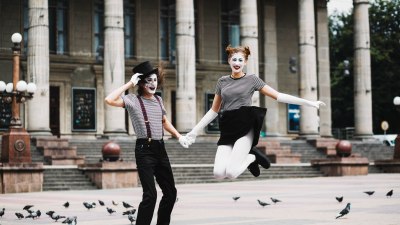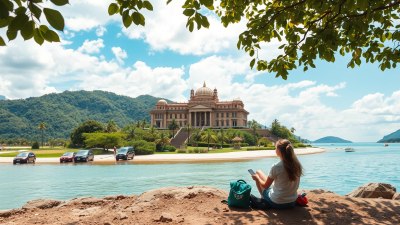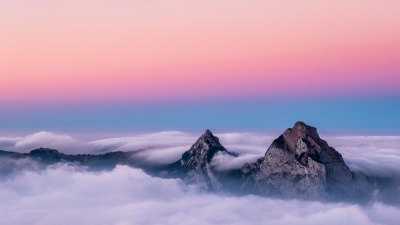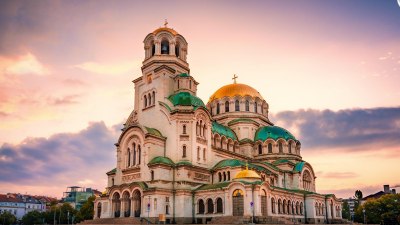Why Every Tourist Attraction Has That One Person Doing an Awkward Photoshoot
Exploring the phenomenon of awkward photoshoots at tourist attractions and their impact on visitors.

Tourist attractions around the world, whether they are iconic landmarks, serene natural landscapes, or bustling city squares, have one thing in common: the presence of that one person who seems utterly engrossed in an awkward photoshoot. You might see someone posing dramatically at the edge of a famous cliff or stretching out as if they're trying to touch a giant statue. This phenomenon, while it may seem bizarre to onlookers, tells us much about human behavior, the influence of social media, and the nature of travel itself.
To begin, we must consider the role of social media in how we experience and share our travels. In today's digital age, taking photos has become a critical part of our journeys. Travelers increasingly curate their experiences into shareable content for platforms like Instagram, Facebook, and TikTok. The desire for that perfect shot can lead to a surge of creativity—and sometimes awkwardness—as individuals strive to capture their experience in the most memorable way possible.
This need for the 'perfect' photo creates situations that may indeed appear awkward. Picture this: a traveler standing hours away from a picturesque view, posing with exaggerated expressions or unnatural angles, hoping to evoke a reaction from their followers. They may twist their body in unnatural ways or raise their arms in a dramatic flair, all for the sake of that coveted ‘like’. The pressure to present a curated version of reality often leads to such peculiar scenarios.
The Social Influence of Photography
Photography has undergone a transformation; it was once an endeavor reserved for professional photographers or special occasions. Now, anyone with a smartphone has the tools to record and project a version of their life. As a result, the social constructs surrounding photography have radically changed. At tourist attractions, people are not just taking simple snapshots; they are performing, bringing attention to themselves in a crowd where many are also trying to stand out.
Moreover, some tourists get inspired by others doing similar quirky poses. This results in a chain reaction whereby witnessing one person attempt an awkward photoshoot encourages others to follow suit, leading to collective hilarity as they try to outdo each other with creativity and awkwardness. This phenomenon becomes a shared experience even among strangers as they collectively engage in the lightheartedness of travel.
The Role of Cultural Expectations
Every culture has its expectations regarding photography and how memories should be captured. Some cultures prioritize serious, composed shots, whereas others celebrate spontaneity and fun. This diversity can lead to amusing and awkward moments as individuals from different backgrounds converge at tourist attractions. What one person considers a perfectly posed picture might be seen as awkward by another, illustrating the subjective nature of photography.
In some cases, cultural differences can result in hilariously mismatched perceptions of what a good photo should include. For example, a traveler might pose dramatically in front of a historical monument that locals consider sacred. Their joy and enthusiasm for the photo op can clash with local customs, generating uncomfortable exchanges—often leading to even more comedic scenarios.
The Psychological Angle
On a psychological level, many individuals seek validation through photo-sharing. The ‘like’ culture incentivizes people to exaggerate moments in their lives, and travel is no exception. Tourists often assume that the more extravagant and unexpected the pose, the more attention it will receive online. This drive can create a cycle where awkwardness becomes synonymous with gaining engagement.
Furthermore, some might engage in such bizarre antics as a method of coping with the overwhelming nature of travel. Being surrounded by beautiful landscapes and iconic structures can lead to feelings of insignificance, causing some individuals to compensate by making themselves the center of attention, even if that means displaying a level of awkwardness unfamiliar to them.
Tourists vs. Locals
There is often a stark contrast between the moments captured by tourists and those experienced by locals. Locals might seek simplicity or representation of their everyday lives, while tourists crave maximum spectacle. Due to this divergence, those who prioritize authenticity may view awkward photoshoots as something trivial or embarrassing. Tourists concerned with presenting their adventures in a visually appealing manner may inadvertently disregard the nuances of their surroundings, emphasizing their odd poses instead.
This tension can also play into how crowds interact. Locals—and even fellow tourists—might chuckle or squint in disbelief as individuals pirouette into bizarre angles to capture a shot. These interactions, laden with humor, encapsulate the essence of tourism: a shared experience in exploring the unfamiliar, often amplified by those moments of silliness.
The Impact of Technology
Today's smartphones, equipped with advanced cameras and editing software, exacerbate this phenomenon. With access to filters and editing tools, snapping what seemed like a subpar shot can instantly transform it into a visually appealing image. This constant access to technology can push individuals to experiment excessively with weird angles, kooky poses, and humorous props to achieve the ultimate shot.
Additionally, features like countdown timers or remote controls allow an individual to pose solo while still engaging the audience back home. Thus, one can showcase their awkward photoshoot without relying solely on a fellow traveler to snap the picture - partly contributing to those ones doing more awkward, solo productions.
In summary, the sight of that one person doing an awkward photoshoot is far more than just a quirky distraction; it encompasses a myriad of cultural, social, and psychological dynamics at play. As individuals escape the mundanity of their daily lives and traverse the globe, the need to document those experiences through unusual and exaggerated poses has grown stronger than ever. Ultimately, these moments of awkwardness connect us, providing laughter and memories that transcend language and culture. So the next time you see someone posing dramatically at a landmark, consider the deeper motivations behind their antics, as they often mirror the universal desire to capture and share the essence of human experience.











